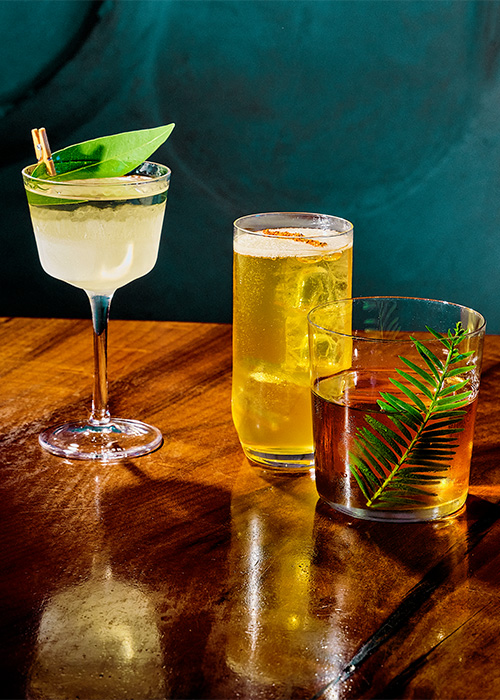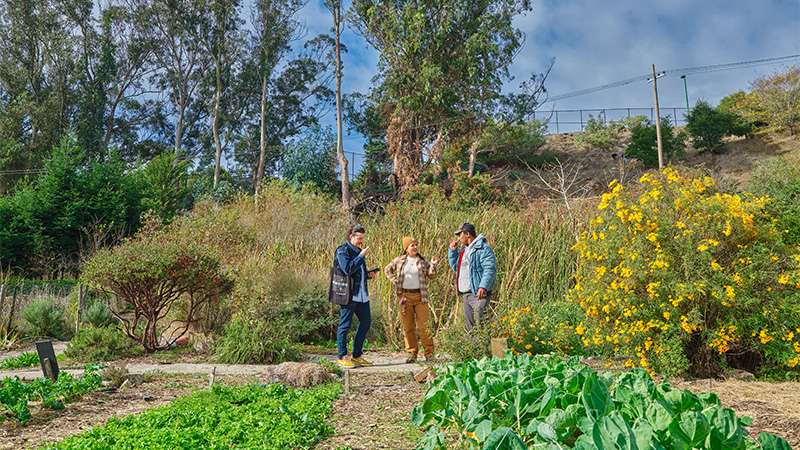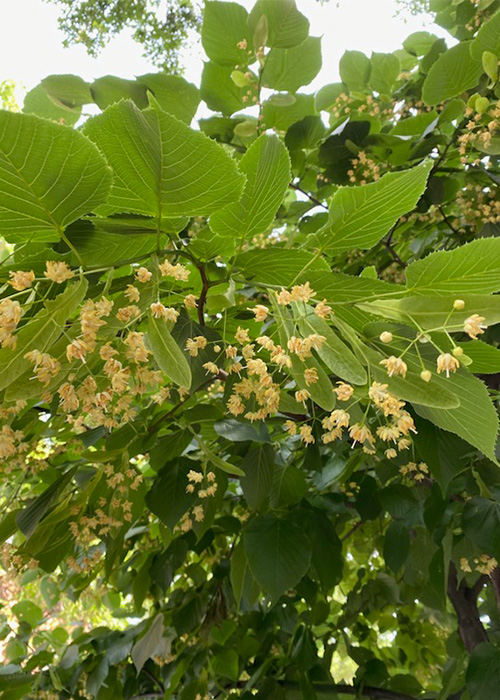After a 12 months penning this column, it’s clear to me that we’ve entered a brand new golden age of cocktails. Good approach and superior expertise are approaching ubiquity — increasingly more bars are adopting centrifuges and rotovaps, the road continues to blur between chef and bartender, and historic texts proceed to be mined to be used in a contemporary context. Whereas the column’s focus has primarily been New York Metropolis, the place I’m primarily based, these developments are proving true across the nation and around the globe.
San Francisco bar True Laurel faucets into the entire aforementioned bells and whistles. Whereas the menu reads unassumingly, it’s riddled with prep-heavy technical work. Clarification, infusion, carbonation, and batching for velocity of service are all throughout the purview of bartender and prep lead Tone Arasa, who was type sufficient to let me in for a peek behind the scenes on a cold Bay Space morning. Because the bar acquired arrange for brunch service, Tone talked me via the methods by which one in every of their drinks makes this system at True Laurel distinctive.
Ninos Peardidos is a completely batched and carbonated cocktail with aged rum, pasilla chili liqueur, rooibos tea, and clarified pear and citrus juices. Clearly, the drink is technically complicated (and completely scrumptious!), however the actual magic lies within the sourcing of components. “We’ve a lot privilege and bounty simply being in California,” Tone explains. It implies that the bar’s entry to farms and markets is high notch year-round, they usually can merely name a farmer or go to them on the market and have world-beating produce for the bar. One other upshot: True Laurel can tackle bruised or blemished fruits from farmers that will have in any other case been unable to promote them; good pores and skin doesn’t have an effect on the flavour of a cocktail, so the staff is comfortable to be an outlet for these scrumptious, if irregular-looking merchandise.
Do not Miss A Drop
Get the newest in beer, wine, and cocktail tradition despatched straight to your inbox.
Sourcing these high-quality uncooked components somewhat than utilizing industrial juices and purees makes for extra complicated and terroir-driven cocktails for visitors. However extra importantly, it integrates the bar right into a group of farmers and producers, and encourages sustainable farming practices. Whereas bars like Kimball Home in Decatur, Ga., and Kingfisher in Durham, N.C., have the same give attention to farms and farmers, the observe hasn’t made the bounce to mainstream within the broader cocktail group. A devotion to seasonality and shut relationships with producers continues to be uncommon and particular.
Wild Substances and Constructing Group
Along with sourcing phenomenal native produce, True Laurel leans closely on foraging the pure bounty of Northern California. Whereas the bar is situated in a decidedly city setting in San Francisco’s Mission District, the distinctive temperate coastal biome of the Bay Space implies that wild and scrumptious botanicals are considerable in every single place — if you recognize the place to look.

Foraging has been a staple of True Laurel’s menu growth for the reason that bar opened in 2017. Upfront of my go to, I related with companion and beverage director Nicholas Torres to find out about why foraging is vital to his staff and the way he acquired into the observe. To my shock, his preliminary forays weren’t for a bar or restaurant. “I used to be working within the nonprofit sector [in the early 2000s] with environmental justice and native habitat restoration as the main target,” he explains. “I started working alongside among the metropolis’s high botanists, horticulturists, and activists. I realized in regards to the native flora, its historic use, and I realized in regards to the invasive flora as effectively.”
This spine of data discovered a beverage utility when Nicholas developed the cocktail program for two-Michelin-starred Lazy Bear, a eating expertise that started as a cocktail party in chef David Barzelay’s house however shortly expanded into one in every of San Francisco’s most artistic eating places. The kitchen staff used foraged components like nasturtium, sorrel, and seaweed in elevated preparations, and Barzelay inspired Nicholas to do the identical in his drinks. Locality, seasonality, and foraging grew to become inexorably intertwined with culinary excellence and sustainability. When Nicholas and chef David opened True Laurel collectively in 2017, the bar grew to become a platform to synthesize the whole lot he’d realized in an extended and winding profession each out and in of hospitality.
“We are able to do lacto fermentations, plus extra tinctures and infusions — stuff that takes an amazing period of time and endurance.”
Whereas visiting True Laurel, and as a follow-up to the Ninos Peardidos cocktail, Tone made me two drinks that showcase foraged components and are perennial menu staples on the bar. The Within the Pines, Underneath the Palms is a spin on a Martinez, with coconut-fat-washed rye whiskey and gin married with vermouth, Maraschino, and arak. The completed cocktail is individually bottled with a juicy, fragrant younger redwood sprig. The liquid is left to macerate on the sprig till its taste profile mimics taking a stroll via one of many redwood groves within the Presidio.

In the meantime, the Laurel Martini combines gin with a slew of vermouths, a foraged bay laurel tincture, and Meyer lemon oil. “California Bay Laurel,” Nicholas explains, “may be very completely different from candy bay laurel — extra eucalyptus-like.” I contemplate myself a full-time Martini drinker, and this one is a revelation: vivid, crisp, with an extended end of juniper and eucalyptus intertwined. I grew up within the Bay Space and have by no means felt as related to the flora of the area as after I drank these cocktails.

For Tone, these two drinks are solely the start. The bar has simply taken on an extra lab area for R&D and storage, an amazing luxurious in a metropolis like San Francisco. “We are able to do lacto fermentations, plus extra tinctures and infusions — stuff that takes an amazing period of time and endurance,” they clarify. Along with laurel and redwood sprigs, the bar additionally makes use of — relying on the season — Islais Creek leaves, chaparral, yarrow, feijoa, cypress, nasturtium, and inexperienced pinecone. One can solely think about the pure bounty they may have the ability to showcase with the enlargement.
Allemany Farm and the 280 Venture
Whereas Nicholas had hoped to be there in particular person to take us on a foraging outing, he was known as away on bar enterprise on the final minute. As a substitute, he saved his devotion to group on the forefront and related me with Chris Renfro, a member of the Core Volunteer Advisory Board of Allemany Farm. The biggest agricultural area throughout the metropolis limits, lots of the components on the True Laurel menu develop wild there. After we completed up on the bar, Tone and I packed up and headed to the farm in order that Chris might present us in-person the place to seek out these crops.

As an outsider approaching for the primary time, Allemany seems to be a modest — although colossal for a metropolis — plot of row crops like kale and radishes sandwiched between a steep hillside and the freeway. Chris arrived and gave us the complete tour, and I instantly realized how a lot this little plot was able to.
As he shepherded us towards Bay Laurel and Islais Creek Cherry leaves (that scent remarkably like cherry cola and can ultimately make their manner right into a True Laurel kumquat cola), Chris gave us an summary of the farm. “Allemany is 2.5 acres of backyard and public park,” he informed us. “Buddies of Allemany Farms stewards the land, volunteers come, they assist. There’s a gaggle of apprentices, plenty of BIPOC, LGBTQ group members that come and assist out. All of the meals and the whole lot grown right here is totally free to the group.”
The time I spent at Allemany demonstrated what units True Laurel aside. After all, the drinks are phenomenal, however the actual story is the work they do to be in and of their group, showcasing native flavors and people who find themselves making life extra truthful, equitable, and scrumptious for his or her neighbors.
Yearly, Allemany grows and provides away 15 tons of produce to surrounding residents. The agricultural work and land stewardship they observe imply that indigenous crops that additionally populate the plot like laurel and redwood are lush, wholesome, and insanely aromatic. The agricultural work feeds nature and the group and makes for extra scrumptious cocktails.

As we walked via the grounds it grew to become clear simply how teeming with life and scrumptious crops this farm is; rose geranium right here, a pineapple guava tree there, persimmons, passionflower, a garter snake slithering, rosemary, Mexican marigold, a coyote den within the distance — it simply went on and on. We made our manner up the precarious hillside the place Chris planted 4 rows of each wine and desk grapes. The vines are an academic device for his group the 280 Venture, which he based in 2019 along with his companion Jannea Tschirch.
“The 280 Venture is a non-profit aimed to get LGBTQ, BIPOC individuals into the wine trade via a paid apprenticeship that we maintain,” Chris defined. “For six months of the rising season, we go to completely different wineries, completely different vineyards, and get individuals, I wouldn’t say simply educated, however skilled within the trade.”

Chris teaches them the fundamentals of viticulture and regenerative agriculture at Allemany to allow them to have a leg up after they get to skilled vineyards. The desk grapes are there to get group members of all ages enthusiastic about farming with one thing that’s scrumptious proper off the vine. It was a exceptional afternoon, one which left me feeling hopeful and full. The time I spent at Allemany demonstrated what units True Laurel aside. After all, the drinks are phenomenal, however the actual story is the work they do to be in and of their group, showcasing native flavors and people who find themselves making life extra truthful, equitable, and scrumptious for his or her neighbors.
Learn how to Get Began Foraging
The attractive factor about foraging is that it’s utterly free and everybody can take benefit. It simply takes slightly information to get on the market. Chris gave me some tricks to get began, and as you may need guessed all of them contain getting energetic with group members and group historical past. He recommends consulting native books and discipline guides on native crops and agriculture — books like Pam Pierce’s “Golden Gate Gardening” — and looking out on-line for native foraging teams. Verify with native libraries as effectively; San Francisco’s Protrero Hill and Portola branches of the general public library have free seed libraries for members (and wouldn’t you recognize it, the NYPL does as effectively!) who’re able to strive their hand at agriculture, in addition to all the sector guides it’s worthwhile to begin harvesting native botanicals.

For the New Yorkers, I’ve acquired the bottom carry doable intro to foraging. At each Booker and Dax and Current Situations, we might showcase native foraging in early to mid-summer when the linden bushes would bloom. The American linden is native to New York, will be discovered wild in Central Park, and is planted in abundance on streets all through Manhattan and Brooklyn. They bloom between June and July relying on the 12 months and the tree; their tiny buds exploding into sweet-smelling flowers. All it’s important to do is pluck the flowers from the tree and wash them and also you’ve acquired an exceptional hand-harvested cocktail ingredient — even when it got here from simply down the block. On the bars, we might nitro muddle the blossoms (freeze them in liquid nitrogen, then muddle them right into a superb powder) earlier than constructing a basic gin bitter on high of them. However for these of you with out entry to liquid nitrogen, conventional muddling will do exactly superb.
Linden Bitter

Substances
- 2 ounces Plymouth gin
- ½ ounce recent lemon juice
- ½ ounce easy syrup
- 5 drops 20 p.c saline resolution (20 grams salt dissolved in 80 grams water)
- 8-10 linden blossoms
Instructions
- Add linden blossoms to a shaker tin.
- Frivolously press with a muddler to launch their aroma; don’t get too aggressive or the drink can be bitter.
- Add the remainder of the components to the tin with the blossoms.
- Fill with ice and shake.
- High-quality-strain into a calming coupe to take away any flower bits.
This story is part of VP Professional, our free platform and e-newsletter for drinks trade professionals, masking wine, beer, liquor, and past. Join VP Professional now!



